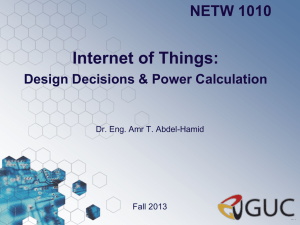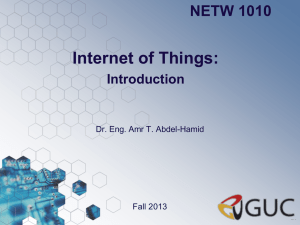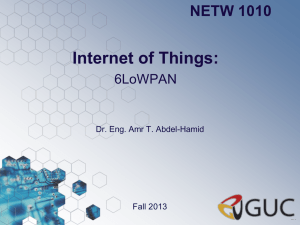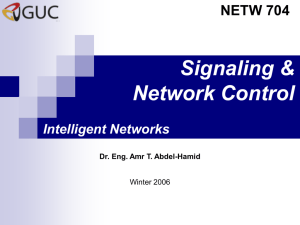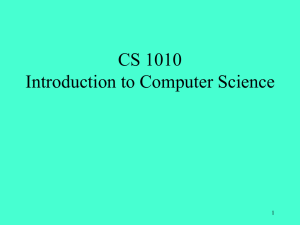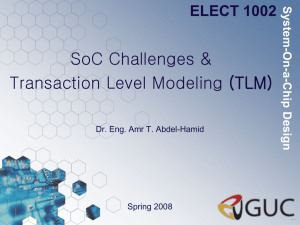PowerPoint 프레젠테이션
advertisement
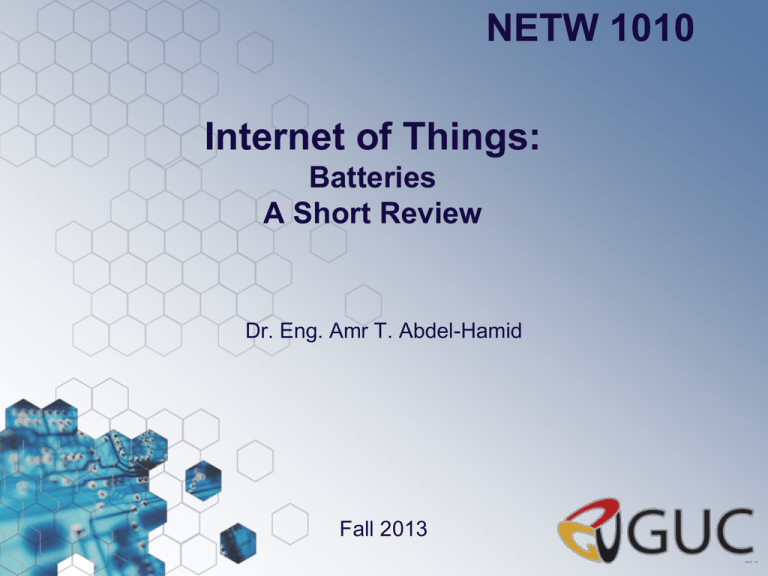
NETW 1010 Internet of Things: Batteries A Short Review Dr. Eng. Amr T. Abdel-Hamid Fall 2013 Eradio Calculations Internet of Things Eradio = (P(per Bit)* Number of Bits)+ (I sleep* V * T) Total Energy used for this module What kind of a battery needed then?! Dr. Amr Talaat NETW 1010 Battery (Short Review) Internet of Things Duracell batteries Two cells 9v battery A real battery 6v dry cell Another battery Dr. Amr Talaat More precisely NETW 1010 Batteries Internet of Things Dr. Amr Talaat Cheap Easy to use Rechargeable batteries available Lithium Ion batteries with high capacity Charging is simple and easy Size of batteries is a problem AA battery defines the size of many devices Environment (temperature) has influence on the capacit y NETW 1010 Battery Characteristics Internet of Things Size Physical: button, AAA, AA, C, D, ... Energy density (watts per gram or cm3) Longevity Capacity (Ah, for drain of C/10 at 20°C) Number of recharge cycles Discharge characteristics (voltage drop) Dr. Amr Talaat NETW 1010 Further Characteristics Internet of Things Cost Behavioral factors Temperature range (storage, operation) Self discharge Memory effect Environmental factors Leakage, gassing, toxicity Shock resistance Dr. Amr Talaat NETW 1010 Battery Organization Internet of Things Dr. Amr Talaat NETW 1010 Battery Connections Internet of Things Dr. Amr Talaat NETW 1010 Primary (Disposable) Batteries Internet of Things Zinc carbon (flashlights, toys) Heavy duty zinc chloride (radios, recorders) Alkaline (all of the above) Lithium (photoflash) Silver, mercury oxide (hearing aid, watches) Zinc air Dr. Amr Talaat NETW 1010 Alkaline Battery Discharge Internet of Things Dr. Amr Talaat NETW 1010 Secondary (Rechargeable) Batteries Internet of Things Nickel cadmium Nickel metal hydride Alkaline Lithium ion Lithium ion polymer Lead acid Dr. Amr Talaat NETW 1010 Nickel Cadmium Batteries Internet of Things Chemistry Cadmium (-), nickel hydroxide (+) Potassium hydroxide aqueous electrolyte Features + Rugged, long life, economical + Good high discharge rate (for power tools) Relatively low energy density Toxic Dr. Amr Talaat NETW 1010 NiCd Recharging Internet of Things Over 1000 cycles (if properly maintained) Fast, simple charge (even after long storage) C/3 to 4C with temperature monitoring Self discharge 10% in first day, then 10%/mo Trickle charge (C/16) will maintain charge Memory effect (Medium Effect over time) Dr. Amr Talaat NETW 1010 NiCd Memory Effect Internet of Things Dr. Amr Talaat NETW 1010 NiMH Battery Discharge Internet of Things Dr. Amr Talaat NETW 1010 NiMH Recharging Internet of Things Less prone to memory than NiCd Shallow discharge better than deep Degrades after 200-300 deep cycles Need regular full discharge to avoid crystals Self discharge 1.5-2.0 more than NiCd Longer charge time than for NiCd To avoid overheating Dr. Amr Talaat NETW 1010 NiCd v NiMH Self-Discharge Internet of Things Dr. Amr Talaat NETW 1010 Secondary Alkaline Batteries Internet of Things Features 50 cycles at 50% discharge No memory effect Shallow discharge better than deeper Dr. Amr Talaat NETW 1010 NiCd v Alkaline Discharge Internet of Things Dr. Amr Talaat NETW 1010 Lithium Ion Batteries Internet of Things Chemistry Graphite (-), cobalt or manganese (+) Nonaqueous electrolyte Features + 40% more capacity than NiCd + Flat discharge (like NiCd) + Self-discharge 50% less than NiCd Expensive Dr. Amr Talaat NETW 1010 Lithium Ion Recharging Internet of Things 300 cycles 50% capacity at 500 cycles Dr. Amr Talaat NETW 1010 Lithium Ion Polymer Batteries Internet of Things Chemistry Graphite (-), cobalt or manganese (+) Nonaqueous electrolyte Features + Slim geometry, flexible shape, light weight + Potentially lower cost (but currently expensive) + Higher discharge Lower energy density, fewer cycles than Li-ion Dr. Amr Talaat NETW 1010 Battery Capacity Internet of Things Type Dr. Amr Talaat Capacity (mAh) 2850 Density (mWh/g) 124 1600 80 NiCd AA 750 41 NiMH AA 1100 51 Lithium ion 1200 100 Lead acid 2000 30 Alkaline AA Rechargeable NETW 1010 Discharge Rates Internet of Things Type Alkaline Voltage Peak Optimal Drain Drain 1.5 0.5C < 0.2C Dr. Amr Talaat NiCd 1.25 20C 1C Nickel metal 1.25 5C < 0.5C 2 5C 0.2C 3.6 2C < 1C Lead acid Lithium ion NETW 1010 Recharging Internet of Things Type Alkaline NiCd Cycles Charge Discharge Cost per (to 80%) time per month kWh 50 (50%) 3-10h 0.3% $95.00 Dr. Amr Talaat 1500 1h 20% $7.50 NiMH 300-500 2-4h 30% $18.50 Li-ion 500-1000 2-4h 10% $24.00 300-500 2-4h 10% Lead acid 200-2000 8-16h 5% Polymer $8.50 NETW 1010 Energy harvesting Internet of Things Dr. Amr Talaat Capacity of battery limits the lifetime of the device Battery depletion -> Device cannot work -> (Sensor) network cann ot work Idea: recharge the batteries during operation Use energy from the environment Current approaches Photovoltaics: Solar modules for sensor nodes Thermoelectric generators Conversion of temperature differences to energy Kinetic energy conversion Piezo-electric principle already tested for shoes MEMS gas turbines Convert air- or fluid streams NETW 1010
